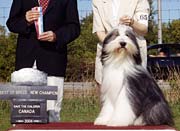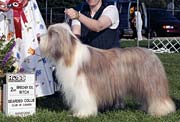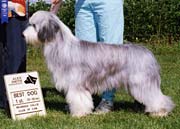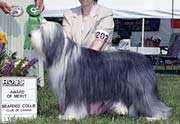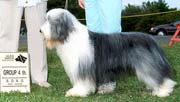Breed standards can vary slightly from country to country.
Read the AKC Breed Standard and the UK Breed Standard.
The following is the official Canadian Kennel Club breed standard, which can also be seen on the CKC website:
Origin and Purpose:
One of the oldest of the British herding breeds, the Bearded Collie has for centuries been the Scottish hill shepherd's dog, used to hunt and gather free-ranging sheep on the Highlands. The breed was also popular as a cattle drover. Both jobs required a hardy constitution and intelligence, initiative, strength, stamina, and speed.
General Appearance:
This is a lean active dog, longer than it is high in an approximate proportion of 5:4, measured from point of chest to point of buttock. Bitches may be slightly longer. The dog, though strongly made, should show plenty of daylight under the body and should not look too heavy. A bright, enquiring expression is a distinctive feature of the breed.
Characteristics and Temperament:
The Bearded Collie must be alert and self-confident, and should be lively and active. The temperament should be that of a steady, intelligent working dog and must show no signs of nervousness or aggression.
Size:
Ideal height at the shoulder: dogs, 21-22 in. (53-56 cm); bitches, 20-21 in. (51-53 cm). Over-all quality and proportions should be considered before size but excessive variations from the ideal height should be discouraged.
Coat:
The coat must be double with the undercoat soft, furry and close. The outer coat should be flat, harsh and strong, shaggy, free from wooliness and curl, though a slight wave is permissable. The length and density of the hair should be sufficient to provide a protective coat and to enhance the shape of the dog, but not enough to obscure the natural lines of the body. The adult coat may break along the spine, but must not be artificially parted. The coat must not be trimmed in any way. On the head, the bridge of the nost should be sparsely covered with hair which should be slightly longer on the sides just to cover the lips. From the cheeks, the lower lips and under the chin, the coat increases in length towards the chest, forming the typical beard.
Colour:
Bearded Collies are born dark, pure black, brown, blue or fawn, with or without white markings. The base colours mature to any shade of black, grey, blue, brown, or fawn, with the coat usually having a mixture of many shades at once and individual hairs showing bands of light and dark. Grey hairs may be lightly interspersed with all colours. Where white occurs, it should only appear on the foreface, as a blaze on the skull, on the tip of the tail, on the chest, legs and feet and, if round the collar, the roots of the white hair should not extend behind the shoulder. White should not appear above the hocks on the outside of the hind legs. Slight tan markings are acceptable on the eyebrows, inside the ears, on the cheeks, under the root of the tail, and on the legs where white joins the main colour.
Head:
The head should be in proportion to the size of the dog. The skull is broad and flat, the distance between stop and occiput being equal to the width between the orifices of the ears. The muzzle is strong and equal in length to the distance between the stop and the occiput, the whole effect being that of a dog with strength of muzzle and plenty of brain room. The stop should be moderate. The nose is large and square. Pigmentation of nose leather, lips, and eye rims follows coat colour at birth and should be of a solid colour without spots or patches. The eyes should be set widely apart and are large, soft and affectionate, but not protruding. The eyebrows are arched up and forward but are not so long as to obscure the eyes. Eyes should tone with coat in colour. Born blues and fawns will have lighter eyes with all shades of coat than born blacks or browns. The ears are of medium size and drooping. When the dog is alert, the ears lift at the base, level with, but not above, the top of the skull, increasing the apparent breadth of the skull. The teeth are large and white, the incisors of the lower jaw fitting tightly behind those of the upper jaw. However, a level bite is acceptable. A full set of forty-two teeth is desirable.
Neck:
The neck must be of a fair length, muscular, and slightly arched.
Forequarters:
The shoulders should slope well back, a line drawn through the centre of the shoulder blade should form a right angle (90 degrees) with the humerus. The shoulder blades at the withers should only be separated by the vertebrae but must slope outwards from there sufficiently to accomodate the desired spring of rib. The legs are straight and vertical, with good bone, and covered with shaggy hair all-round. The pasterns should be flexible without weakness.
Body:
The length of the back should come from the length of the rib cage and not that of the loin. The ribs are well sprung but angled back, making the rib cage appear flat, and the chest is deep, giving plenty of heart and lung room. The back must be level and the loins should be strong. The level back blends smoothly into the curve of the rump and must not fall away in croup.
Hindquarters:
The hindquarters are well muscels with good second thighs, well-bent stifles and low hocks. Below the hock, the leg falls at a right angle to the ground and, in normal stance, will be just behind a line vertically below the point of the buttock. The distance between the hocks should approximate the distance from hock to ground.
Feet:
The feet are oval in shape with the soles well padded. The toes are arched and close together, well covered with hair including between the pads.
Tail:
The tail is set low, without kink or twist, and is long enough for the end of the bone to reach at least the point of the hock. It is carried low with an upward swirl at the tip while standing. When the dog is excited or in motion the tail may be extended or raised, but must not be carried forward over the back.
Gait:
Seen from the side, a correctly moving dog appears to flow across the ground with the minimum of effort. Movement should be supple, smooth, and long-reaching, with good driving power in the hindquarters and feet lifted just enough to clear the ground. The forelegs should track smoothly and straight. Each hind leg should move in line with the foreleg on the same side. The back should remain level and firm.







